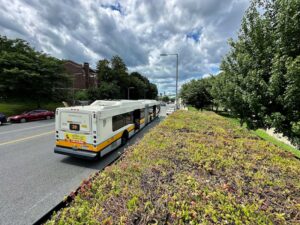Who is a member?
Our members are the local governments of Massachusetts and their elected and appointed leadership.

The city of Boston has installed green, vegetation-covered roofs on 30 bus shelters along a popular route to provide cooling and help manage stormwater. (Photo courtesy city of Boston/Trevor Smith at Weston Nurseries)
Boston has added “green” roofs to 30 bus shelters along a popular route, shielding bus riders from increasingly hot weather, and better equipping neighborhoods to manage stormwater runoff and flooding risks.
As part of a three-year demonstration program, Boston installed the green roofs with drought-resistant plantings in August along the MBTA’s 28 bus route. By adding the greenery, Boston is hoping the roofs will provide a cooler and shadier alternative to the traditional clear roofs, serve as stormwater containers, improve air quality, and add much-needed vegetation and biodiversity to a key corridor of the city. The city believes its installation is the largest nationwide.
The city selected the 28 bus route because of its high ridership and status as one of Boston’s free-fare bus routes serving more vulnerable residents, a majority of whom are classified as living in low-income households. The route also traverses several inner-city neighborhoods that disproportionately experience extreme climate impacts, including heat.
“These green roofs on bus shelters are not just a representation of Boston’s progress on sustainability — they are a practical, scalable solution to some of the most pressing challenges we face as a city,” Mayor Michelle Wu said in a prepared statement.
The project involves numerous city departments and offices, including the Mayor’s Office, climate resilience, environment, green infrastructure, property management and transportation. In addition, the city has been working with the MBTA; JCDecaux, the city’s street furniture contractor and owner of the bus shelters; Social Impact Collective, a minority-owned architecture and design firm; Weston Nurseries; and the nonprofit YouthBuild Boston.
The current demonstration program has been about a year in the making, but the concept stretches back about a decade, said Zoe Davis, senior climate resilience project manager for the Office of Climate Resilience. While researching ways to provide shade and cooling at bus shelters, she said, her team discovered that Social Impact Collective had undertaken a brief demonstration of green bus shelter roofs about 10 years ago.
“The original pilot only lasted for a summer,” Davis said. “We wanted to know if this type of green infrastructure on bus shelters is something that we wanted to expand, and potentially integrate, into a standard design of our bus shelters, as a part of our longer term climate resilience goals.”
The project aligns with Heat Resilience Solutions for Boston, the city’s 2022 plan to protect residents and neighborhoods from the effects of extreme temperatures, and advances the city’s environmental justice goals.
Sitting atop a waterproof layer, the green roofs contain numerous types of drought-resistant sedum plant ground cover. The succulents are fairly resilient, good at storing water and have shallow root systems, Davis said. This fall and next spring, she said, the city will add native plants to enhance the roofs’ ecological value and attractiveness to pollinators. The city is hoping the roofs attract bees, butterflies, birds and insects, she said.
Working with Social Impact Collective, the city will collect data to determine the benefits of the green roofs, examining the effects on plant growth, heat reduction and air quality; the amount of stormwater retained by the roofs; the presence of pollinators and biodiversity; and the water quality of the vegetation-filtered runoff. Davis said they are especially interested to learn what happens to the roofs over the winter months and during heavy rainfalls.
If the demonstration program goes well, the city may look to expand it to other locations. The city’s current contract for street furniture will be up in a few years, Davis said, providing an opportunity for the city to embed climate resilience needs into future contracts, and integrate climate solutions into standard design.